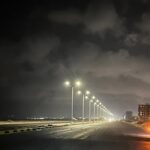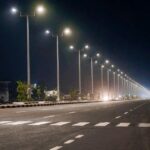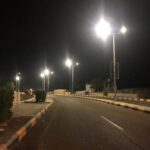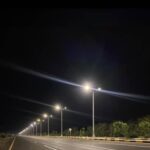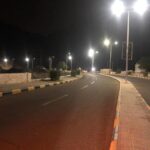Solar street lights have become a popular and sustainable lighting solution for residential areas, providing bright illumination while minimizing electricity costs. As homeowners embrace the benefits of solar energy, it is essential to understand the importance of regular maintenance to ensure optimal performance and longevity of your solar street light. By following a few simple tips, you can keep your solar street light in excellent condition, maximizing its efficiency and extending its lifespan. Let’s explore key maintenance practices that will help you maintain your solar street light for home use.
Tips To Maintain Your Solar Street Light For Home Use
What should you do to lengthen the lifespan of your solar street light for home use?
1. Regular Cleaning
When you actively clean your solar street light for home use, you effectively eliminate dirt, dust, and other debris that can accumulate on its various components. The debris can cause your street light to stop working. Cleaning the solar panel, for instance, ensures maximum absorption of sunlight, which directly impacts the light’s charging capabilities. By removing any dirt or grime that may obstruct the solar panel, you allow it to receive the full intensity of sunlight, enabling efficient conversion of solar energy into electrical power.
Additionally, cleaning the light fixture itself helps to maintain its brightness and visibility. Over time, dust and dirt particles can settle on the light’s surface, reducing its luminosity and overall effectiveness. By regularly cleaning the solar street light for home use, you ensure that the light remains clear and unobstructed, maximizing its illumination and ensuring better visibility during nighttime.
2. Inspect for Damage
Regular inspection allows you to detect any physical damage that may have occurred due to external factors such as harsh weather conditions or accidental impacts. Active examination of the solar panels, light fixture, and supporting structures enables one to identify cracks, dents, or other visible signs of damage. By promptly repairing or replacing the affected components, the overall functionality and efficiency of the solar street light for home use can be preserved.
Furthermore, inspecting for damage also helps in identifying potential electrical problems. By actively examining the wiring, connections, and controls, any loose or frayed wires can be detected, preventing potential hazards such as short circuits or electrical malfunctions. Addressing these issues in a timely manner ensures the safety of the home and its surroundings.
3. Check for Shading
Shading can occur when objects, such as trees, buildings, or other structures, obstruct sunlight from reaching the solar panels of the street light. This obstruction significantly affects the light’s ability to capture solar energy efficiently and convert it into electricity. Consequently, shading can lead to reduced brightness, shortened operating hours, or even complete shutdown of the street light.
Considering the placement and orientation of the solar street light for home use is vital to minimize shading. Ensuring that the panels face the sun directly and are not blocked by any nearby objects optimizes their exposure to sunlight throughout the day. By carefully positioning the street light and avoiding potential shading sources, you can maximize the energy production and reliability of your solar street light system.
4. Monitor Battery Health
Regularly assessing the battery’s health allows you to identify any potential issues or degradation early on. You can actively monitor key parameters such as the battery’s voltage levels, charge cycles, and overall capacity. This proactive approach empowers you to take timely actions, preventing any unforeseen power outages or system malfunctions.
When monitoring battery health, you can detect signs of aging or degradation. These signs may include reduced charging efficiency, decreased capacity, or increased internal resistance. By promptly identifying such indicators, you can take appropriate measures like recalibrating the system or replacing the battery, avoiding prolonged downtime and costly repairs.
5. Test the Light Output
Regularly examining the light output allows you to gauge the efficiency of the solar panels and the overall health of the system. By analyzing the brightness and coverage of the light, you can identify any potential issues such as decreased performance or malfunctioning components.
Testing the light output also helps you monitor the performance of the battery. If the light output is consistently weak or inconsistent, it could indicate a problem with the battery’s capacity or charging capabilities. By promptly identifying such issues, you can take corrective measures to maintain the battery’s efficiency and ensure uninterrupted operation of the solar street light.
Additionally, evaluating the light output aids in assessing the impact of external factors on the system’s performance. Changes in weather conditions, such as cloudy or overcast days, can affect the amount of sunlight received by the solar panels, directly impacting the light output. By regularly testing the light output, we can monitor these variations and make necessary adjustments to optimize the system’s performance.
6. Inspect Wiring and Connections
Regularly inspecting the wiring and connections enables you to identify any loose or damaged components. Loose connections can result in power interruptions or even complete system failure. By tightening loose connections, you can restore the flow of electricity and prevent potential hazards. Additionally, inspecting the wiring allows you to detect any signs of wear, such as frayed wires or corroded connectors.
Inspecting the connections enables you to detect any potential issues caused by environmental factors. Over time, exposure to various weather conditions can lead to wear and tear on the wiring and connections of the solar street light for home use. This enables them to take timely action, such as replacing damaged wires or connectors, to ensure the system operates optimally and safely.
7. Protect from Extreme Weather
When protected from heavy rainfall, the solar street light for home use remains functional and efficient. Rainwater can potentially seep into electrical components, causing short circuits or damage. However, by implementing proper protection measures, such as waterproof enclosures or covers, we prevent water from infiltrating the sensitive areas of the light. This preservation ensures that the solar street light continues to illuminate reliably even during rainy seasons.
Extreme heat can adversely affect the lifespan and performance of the solar street light for home use. Prolonged exposure to high temperatures can lead to overheating, which can damage critical components such as the solar panel or battery. Therefore, shielding the street light from excessive heat, through appropriate shading or insulation, safeguards its operational efficiency and prolongs its lifespan.
8. Maintain Proper Positioning
One key benefit of maintaining proper positioning is the effective absorption of sunlight. When the solar street light for home use is correctly positioned, its solar panel receives direct sunlight for extended periods, allowing it to efficiently convert solar energy into electrical power. This ensures that the battery within the street light is adequately charged, enabling the light to illuminate the surroundings during nighttime.
In addition, maintaining proper positioning facilitates easy access for maintenance purposes. Placing your solar street light for home use in a location where it is easily reachable simplifies the process of cleaning the solar panels and inspecting the components. Regular maintenance and cleaning are vital for preserving the longevity and efficiency of the light, as they prevent dust, dirt, or debris accumulation that can reduce the solar panel’s ability to absorb sunlight effectively.
9. Keep Records
Recording important details about your solar street light for home use allows you to monitor its efficiency and identify any patterns or issues that may arise over time. By regularly documenting factors such as power output, battery health, and charging behavior, you gain valuable insights into the overall health of your solar street light system.
Furthermore, keeping records enables you to track maintenance tasks and their frequency. By noting down dates of cleaning, inspections, or any repairs undertaken, you establish a clear timeline of your maintenance efforts. This helps you stay organized and ensures that you never overlook crucial maintenance activities.
Conclusion
Maintaining your solar street light for home use is a crucial element to ensure it serves the purpose. Implementing these tips and tricks will help you extend the lifespan of your lighting solution. Remember to consult the manufacturer or consultant in case you need assistance. Contact us now and ensure that your solar system continues to shine brightly for years to come.








